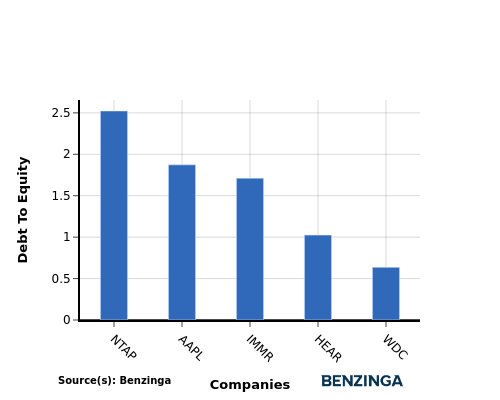In the fast-paced and highly competitive business world of today, conducting thorough company analysis is essential for investors and industry observers. In this article, we will conduct an extensive industry comparison, evaluating Apple AAPL in relation to its major competitors in the Technology Hardware, Storage & Peripherals industry. Through a detailed examination of key financial metrics, market standing, and growth prospects, our objective is to provide valuable insights and illuminate company's performance in the industry.
Apple Background
Apple is among the largest companies in the world, with a broad portfolio of hardware and software products targeted at consumers and businesses. Apple's iPhone makes up a majority of the firm sales, and Apple's other products like Mac, iPad, and Watch are designed around the iPhone as the focal point of an expansive software ecosystem. Apple has progressively worked to add new applications, like streaming video, subscription bundles, and augmented reality. The firm designs its own software and semiconductors while working with subcontractors like Foxconn and TSMC to build its products and chips. Slightly less than half of Apple's sales come directly through its flagship stores, with a majority of sales coming indirectly through partnerships and distribution.
| Company | P/E | P/B | P/S | ROE | EBITDA (in billions) | Gross Profit (in billions) | Revenue Growth |
|---|---|---|---|---|---|---|---|
| Apple Inc | 38.66 | 62.39 | 9.26 | 23.83% | $32.5 | $43.88 | 6.07% |
| Hewlett Packard Enterprise Co | 15.70 | 1.30 | 1.01 | 2.34% | $1.23 | $2.44 | 10.11% |
| NetApp Inc | 23.87 | 29.54 | 4.23 | 32.84% | $0.44 | $1.18 | 6.15% |
| Western Digital Corp | 80.24 | 2.17 | 1.70 | 4.28% | $0.86 | $1.55 | 48.91% |
| Super Micro Computer Inc | 17.14 | 3.69 | 1.39 | 6.68% | $0.4 | $0.6 | 37.87% |
| Pure Storage Inc | 126.40 | 12.31 | 6.34 | 2.52% | $0.08 | $0.54 | 10.91% |
| Eastman Kodak Co | 9.46 | 0.54 | 0.58 | 1.34% | $0.04 | $0.04 | -2.97% |
| Turtle Beach Corp | 53.87 | 3.29 | 0.99 | 3.3% | $0.01 | $0.03 | 59.51% |
| Immersion Corp | 4.97 | 1.25 | 1.77 | 13.41% | $0.03 | $0.06 | 1323.8% |
| AstroNova Inc | 18.08 | 1.25 | 0.77 | -0.34% | $0.0 | $0.01 | 14.12% |
| Average | 38.86 | 6.15 | 2.09 | 7.37% | $0.34 | $0.72 | 167.6% |
Through a meticulous analysis of Apple, we can observe the following trends:
-
The stock's Price to Earnings ratio of 38.66 is lower than the industry average by 0.99x, suggesting potential value in the eyes of market participants.
-
With a Price to Book ratio of 62.39, which is 10.14x the industry average, Apple might be considered overvalued in terms of its book value, as it is trading at a higher multiple compared to its industry peers.
-
With a relatively high Price to Sales ratio of 9.26, which is 4.43x the industry average, the stock might be considered overvalued based on sales performance.
-
With a Return on Equity (ROE) of 23.83% that is 16.46% above the industry average, it appears that the company exhibits efficient use of equity to generate profits.
-
Compared to its industry, the company has higher Earnings Before Interest, Taxes, Depreciation, and Amortization (EBITDA) of $32.5 Billion, which is 95.59x above the industry average, indicating stronger profitability and robust cash flow generation.
-
With higher gross profit of $43.88 Billion, which indicates 60.94x above the industry average, the company demonstrates stronger profitability and higher earnings from its core operations.
-
The company's revenue growth of 6.07% is significantly lower compared to the industry average of 167.6%. This indicates a potential fall in the company's sales performance.
Debt To Equity Ratio

The debt-to-equity (D/E) ratio indicates the proportion of debt and equity used by a company to finance its assets and operations.
Considering the debt-to-equity ratio in industry comparisons allows for a concise evaluation of a company's financial health and risk profile, aiding in informed decision-making.
When comparing Apple with its top 4 peers based on the Debt-to-Equity ratio, the following insights can be observed:
-
In terms of the debt-to-equity ratio, Apple is positioned in the middle among its top 4 peers.
-
This suggests a relatively balanced financial structure, where the company maintains a moderate level of debt while also utilizing equity financing with a debt-to-equity ratio of 1.87.
Key Takeaways
For Apple in the Technology Hardware, Storage & Peripherals industry, the PE ratio is low compared to peers, indicating potential undervaluation. The high PB and PS ratios suggest that the market values Apple's assets and sales highly. Apple's high ROE, EBITDA, and gross profit reflect strong profitability, while the low revenue growth may indicate a need for expansion strategies to align with industry trends.
This article was generated by Benzinga's automated content engine and reviewed by an editor.
Edge Rankings
Price Trend
© 2025 Benzinga.com. Benzinga does not provide investment advice. All rights reserved.
Trade confidently with insights and alerts from analyst ratings, free reports and breaking news that affects the stocks you care about.